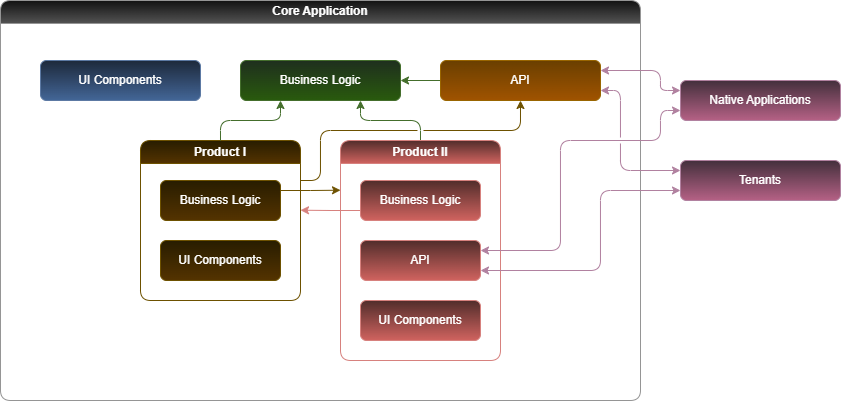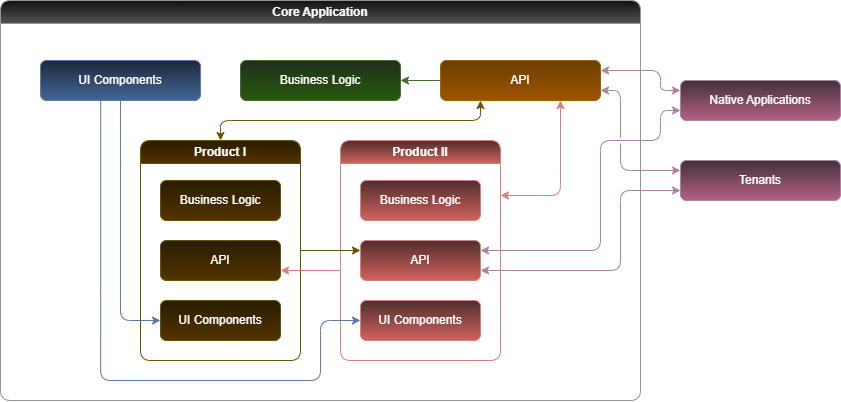Over the past year, I have participated in several migration projects involving traditional monolithic applications. These endeavors were quite insightful, motivating me to share my experience through this new article series.
Before we begin, I'd like to point out that the series is an exercise in planning and continuously publishing long-form content – thus, the contents of this series will revolve around a fictitious application.
Defining the Entry Point
Let's consider a monolithic application employing a popular framework like Symfony, Rails or Django. This framework handles the majority of our application business logic in the backend and is the backbone of our fictitious product.
Our frontend utilizes the framework's provided templating system and relies on a bridge for interactions between client and server. We might also expose an external API for mobile applications or external tenants to utilize.
These considerations condense into the traditional definition of a monolithic stack — one codebase to rule them all. This architecture works well for its intended use case most of the time, as proven by time itself.
Although this structure is effective initially, it has certain architectural limitations that become apparent as complexity increases. These limitations lead to challenges such as API misalignment, difficulty with product expansion, and reduced cohesion.
The first Problems appear
This series requires introducing the necessary crux and foundational understanding to motivate migration to a different architectural approach. To that end, we will present and analyze concrete implementations and design patterns that directly conflict with the traditional monolithic approach.
Problem 1: APIs
External applications, such as mobile apps and third-party vendors, rely on an API to interact with the core application. In a monolithic architecture, the API layer often becomes tightly coupled with internal business logic, exposing implementation details rather than business capabilities.
This coupling means internal refactoring can break external integrations, and API versioning becomes complex as changes ripple through the codebase. Different external consumers requiring different data representations lead to API bloat where endpoints inefficiently serve multiple use cases.
Problem 2: Products
As the application grows, distinct products within the monolith begin to exhibit different scaling requirements, release cycles, and team ownership patterns. Each product may need specialized data models, unique business rules, and different performance characteristics.
However, in a monolithic architecture, all products must share the same technology stack. This creates bottlenecks where teams cannot iterate independently, leading to coordination overhead and slower feature delivery.
Problem 3: Cohesion
As the application expands to serve multiple products, the codebase develops inappropriate coupling between unrelated business domains. Teams inadvertently create shared utilities and services that become tightly coupled across product boundaries, making changes risky and testing complex.
The shared database becomes a bottleneck where schema changes require coordination across all teams. Additionally, UI components become overly generic to accommodate different product requirements, resulting in suboptimal user experiences and harder-to-maintain frontend code.
This creates a situation where business logic that should be cohesive within product boundaries becomes scattered across shared components, while unrelated products become coupled through these shared dependencies.
A fork in the Road opens up
We're faced with a strategic decision that will determine the future scalability and maintainability of our application. Before making this choice, we need to evaluate concrete evidence from our current situation.
Current Pain Points Analysis
- Development Velocity: Feature development requires extensive cross-team coordination, extending lead times from days to weeks due to shared conflicts
- Database Management: Schema changes require extensive cross-team coordination to avoid breaking existing functionality
- API Evolution: API evolution has become constrained by the need to maintain backward compatibility across tightly coupled internal components
Alternative Approaches Considered
- Monolith Optimization: Implementing stricter internal boundaries, domain-driven design principles, and better governance processes
- Gradual Service Extraction: Incrementally extracting bounded contexts into separate services while maintaining monolithic core
- Full Microservices Migration: Complete decomposition into independent services with separate databases, deployment pipelines, and infrastructure
Decision Rationale
For our fictitious scenario, we assume a mid-sized engineering organization where multiple product teams have outgrown monolithic coordination, making cross-team dependencies a bottleneck to independent development.
Monolith optimization would require significant organizational changes that may not scale with growth, while full microservices would introduce operational complexity beyond the team's current capabilities.
The gradual service extraction path provides a balanced approach that addresses coordination bottlenecks while managing the transition complexity through incremental changes and shared infrastructure services.
Conceptualizing the Target
To give you a better picture, I've visualized a rudimentary diagram of the current monolithic core application, its contained products as well as external factors such as native applications and third-party tenants.

The current architecture exhibits several architectural anti-patterns. The circular dependency between business logic and API layers creates a situation where changes in either layer can cascade unpredictably throughout the system.
Products are tightly coupled modules sharing database schemas and business logic, preventing independent evolution. External integrations bypass API boundaries and connect directly to internal components, creating hidden dependencies that make the system brittle and hard to test.
Our target architecture eliminates problematic coupling while preserving shared infrastructure benefits. The proposed modular design establishes clear product boundaries with a unified API gateway and shared core services.

Architectural Approach
API Layer Redesign: The API layer decouples from internal business logic, acting as a composition layer coordinating product-specific service calls. This requires addressing service discovery, circuit breakers, and partial failures through retry mechanisms and fallback strategies.
Product Isolation: Each product maintains its bounded context with dedicated business logic and data models. This creates data consistency challenges across boundaries, addressed through eventual consistency patterns using event sourcing for cross-product synchronization.
Shared Infrastructure: Centralized services handle authentication, logging, monitoring, and core UI components. This hybrid approach reduces operational complexity versus full microservices while providing product autonomy, requiring careful versioning to avoid shared dependency bottlenecks.
Trade-offs and Risks
- Data Consistency: Moving from predefined transactions to eventual consistency patterns may require significant business process changes
- Performance Overhead: Network calls between services introduce latency that must be optimized through caching and intelligent service placement
- Testing Complexity: Integration testing across service boundaries requires sophisticated testing strategies and infrastructure
The success of this migration depends fundamentally on our organization's ability to gradually build operational maturity and develop distributed systems expertise while systematically extracting services incrementally through carefully planned phases that minimize business disruption.
Key Architectural Benefits:
- Eliminated Circular Dependencies: The modular architecture removes circular dependencies between business logic and API layers by introducing clear layered architecture where the API gateway orchestrates calls to independent services without coupling to their implementations.
- Clear Module Boundaries: Products are now encapsulated as distinct bounded contexts with their own data stores and business logic, enabling teams to work independently while maintaining well-defined contracts for inter-service communication.
- Shared Infrastructure Services: Common cross-cutting concerns like authentication, monitoring, logging, and UI components are centralized as shared services, enabling products to focus on their core business logic while maintaining consistency across the platform.
Next article
With our target architecture defined, we need a systematic migration strategy. This requires assessing the current codebase to identify boundaries, dependencies, and risks, then establishing a phased approach for incremental migration without business disruption.
TL;DR
This article explores transitioning from monolithic to modular architectures by identifying technical and organizational challenges. The author analyzes three problems: API coupling complexity, product isolation needs, and decreased cohesion with cross-team dependencies.
The proposed solution is a modular architecture that addresses these issues through clear service boundaries, shared infrastructure services, and an API gateway pattern that enables independent product evolution while maintaining operational efficiency.

